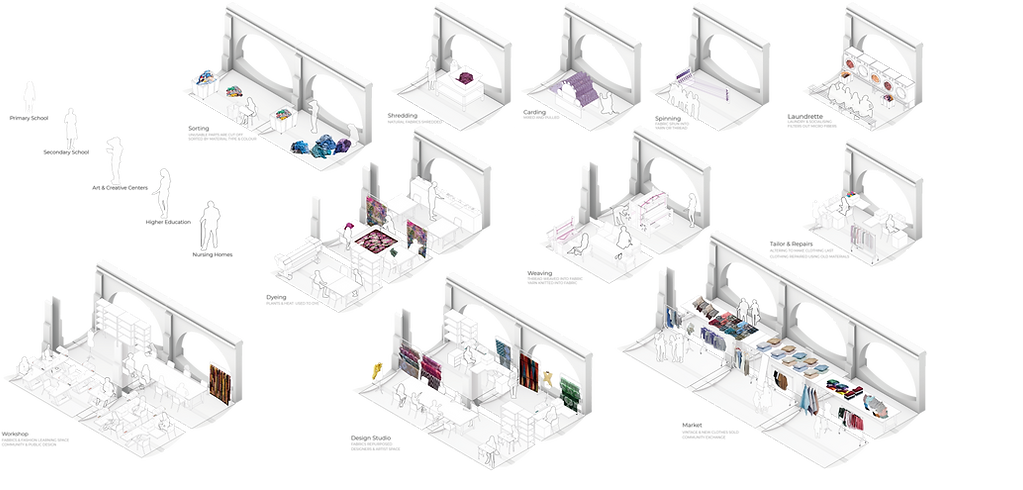top of page
Finsbury Fabric District
Finsbury’s Fabric District combats the environmental impact of textiles throughout their life-cycle through the act of bringing together the diverse local community.
Different ages and cultures bring a variety of skills and textiles to the common. By recycling, designing, making and sharing together, they create a space and style that truly reflects the community.
Finsbury Park Reservoir, London
BSc Year 3
Tutor: Andrea Bugli, AL_A
The Problem: The Textile Industry

Global Recycling Network
The polished side of the textile industry is all consumers see. Thousands of new products are ordered cheaply online to arrive the next day and equally as many are disposed of into clothing bins on the street the following week.
The underside of the industry is darker; unethical labour, unsustainable land use, water pollution and air pollution. We as a society are disconnected from our waste and need to take responsibility within our own communities.

How does the textile industry measure up?


Whats your water footprint?


Can we localise Recycling?
London is a world fashion capital.
23% these enterprises & employments are based in East London.
Some upper class brands create recycled fashion, but the material is not locally sourced and they are inaccessible to most members of the community.








Mapping the Local Community
Mapping the Local Community

A Textile Tale: Fashioning a Common
The common creates an accessible, constructive social space that connects the community through the process of designing, making, recycling, maintaining and wearing clothing; involving them in every point in the process. Donated textiles from the community reflect the different demographics which, when used to make new clothes, creates a style designed, made and worn by the community that reflects the community.
Concept: Fashioning a Common


Carving out the Common
The cavernous underground of Finsbury Park Reservoir was built in 1876 and is able to hold 50 million gallons of water in its seemingly endless grid of brick arches.
Carving out the Common

The underground is inextricably associated with the under-represented and the repressed, its where labour is performed, goods are processed and pollution accumulates.

The Fabric of the Common
The Fabric of the Common

The threshold to the underground serves as a conduit between our plane of existence and a radically different space below.
Just like the world of the underground should be explored not explained, recycling is a multi-linear process rather than a linear Fordist one. The zoning plan shows different clouds of activities which frame the openings, allowing for lights and connection between different processes. The clouds of activity are actualised through the use of fabric. This fabric ensures the space is fluid and can change depending on the user’s needs, depending on workshops, fashion events or market needs.


To allow the flexibility of the reservoir, fabric output from the recycling process is used to create partitions, furniture and to guide you through the space. This forms the soft-scape, allowing the user to define their own space and the merging or separation of spaces as needed.
Further, the fabric attempts to bridge the outer and inner through softening the threshold, between the surface and sub-surface and providing a way to climb up and down into the structure.
Water below the courtyard alludes to the reservoirs history whilst reflecting the fabric floating above and the fluidity of the common.


Technical Details
bottom of page







